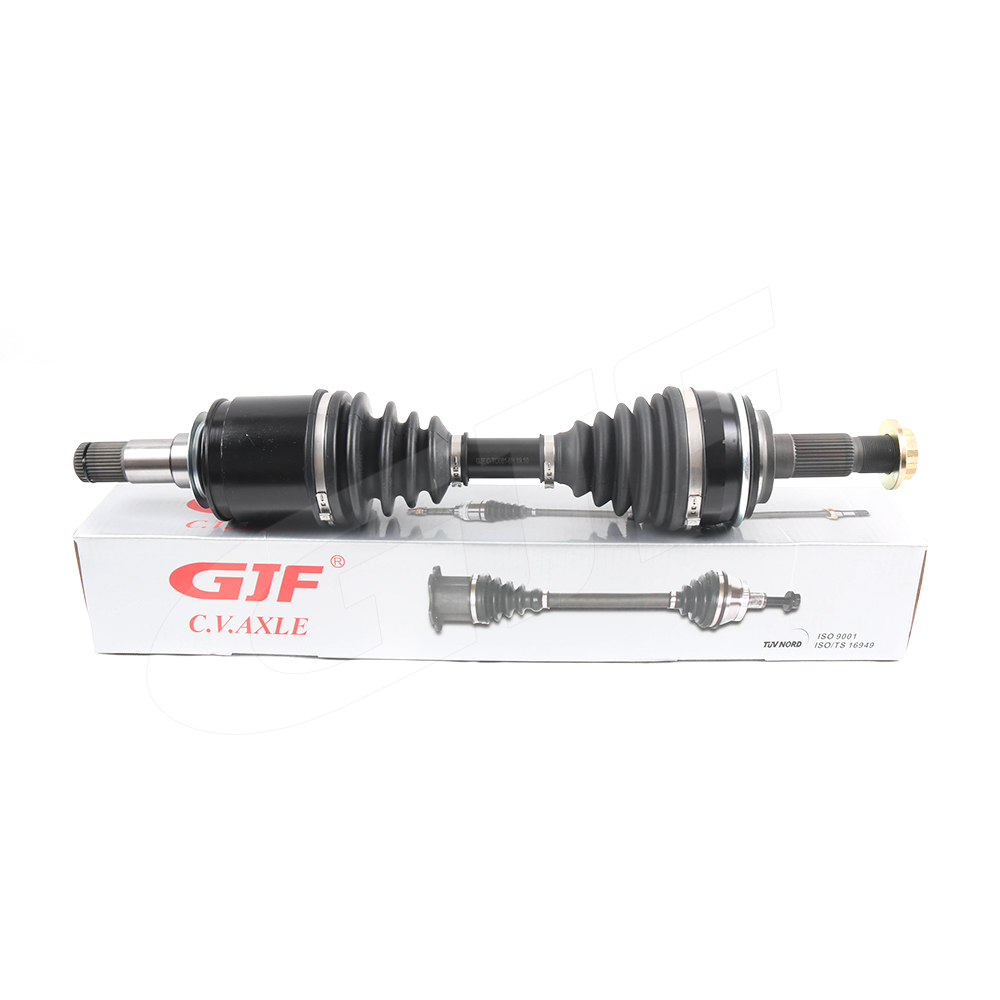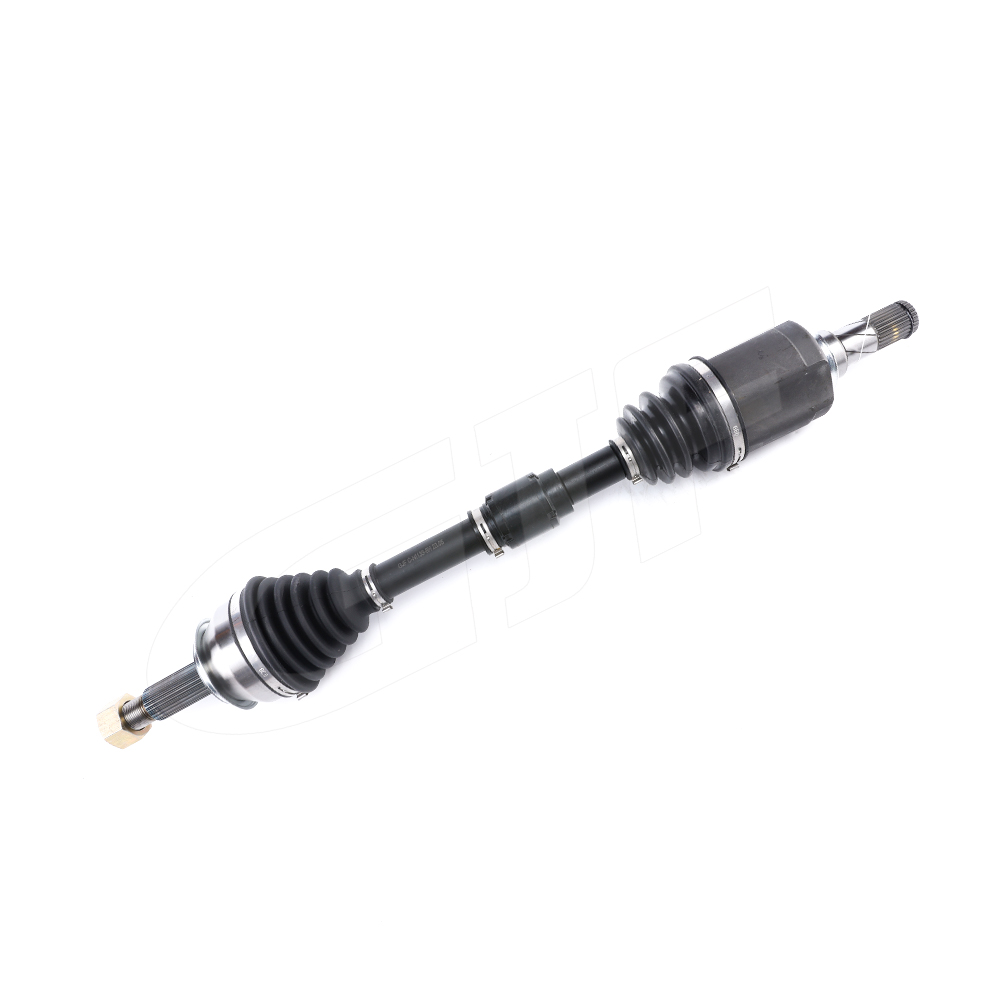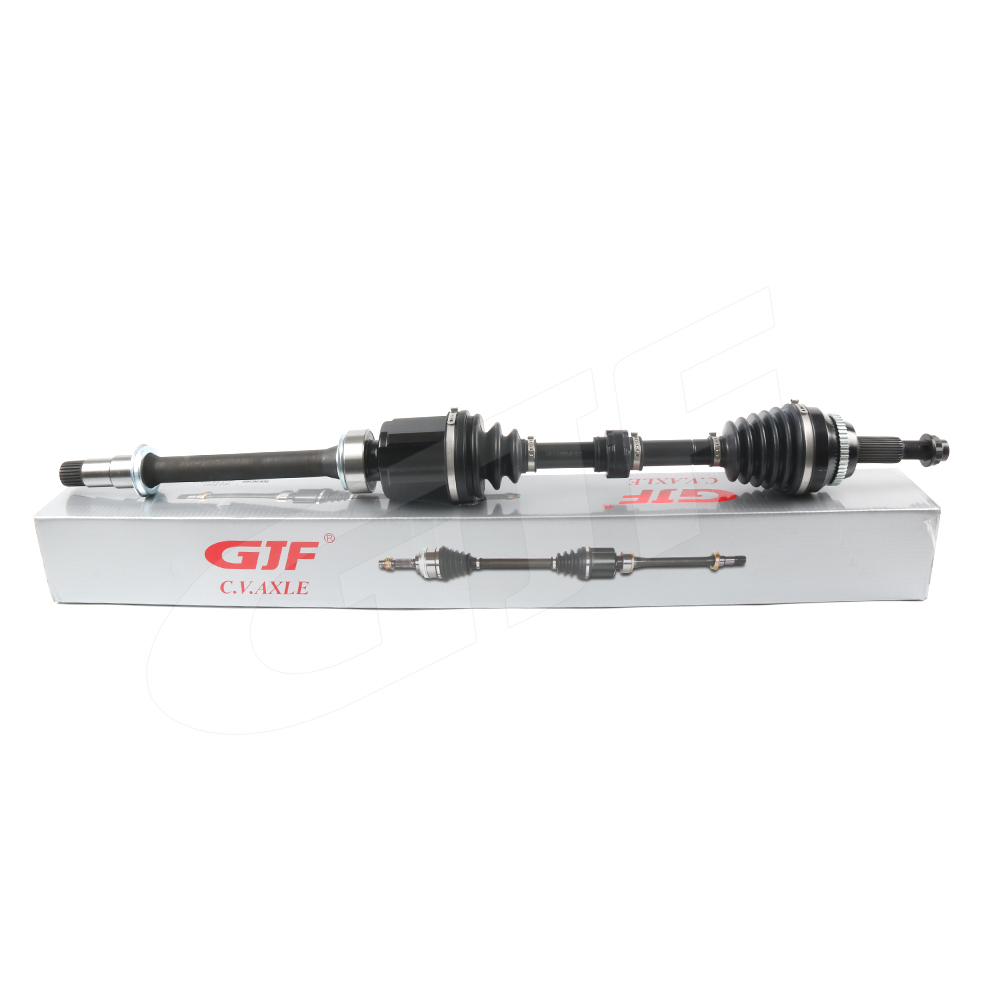

Ever wondered how your car moves when you press the gas pedal? The drive shaft is the key component behind that power transfer. Also known as the propeller shaft, driveline, or prop shaft, it plays a crucial role in transmitting torque from the engine to the wheels. In this post, we’ll explore what a drive shaft is, how it works, and why it's essential for vehicle performance.

A drive shaft is essential for transmitting power from your vehicle's engine to its wheels. When you accelerate, the engine generates rotational power, which is transferred through the drive shaft to the wheels. This process allows the vehicle to move, driving both the front and rear wheels depending on the vehicle type. The drive shaft connects to the engine via a universal joint (U-joint). This flexible connection helps maintain power flow even as the vehicle moves and turns, adjusting to different angles without breaking the power transmission.
The drive shaft ensures smooth and consistent movement of the vehicle. It allows for proper vehicle acceleration and enhances overall performance. Without it, the vehicle wouldn't be able to transfer power effectively from the engine to the wheels, affecting both speed and stability. It’s crucial for efficient operation, especially in various driving conditions, such as during acceleration, braking, or when going uphill.
A single-piece shaft, as the name suggests, is a continuous, unbroken shaft. It’s typically made of steel or aluminum, and is simple and cost-effective for many vehicles.
Pros: Lightweight and easy to maintain.
Cons: It can be too short for larger vehicles with longer distances between the engine and the rear axle.
This type of drive shaft is commonly used in larger vehicles or four-wheel drives, where the distance between the engine and rear axle is too long for a single piece shaft. It’s divided into two or three parts connected by joints.
Pros: Reduces stress on the components and allows for better handling on uneven terrain.
Cons: More complex, requiring more maintenance and potentially more expensive.
In front-wheel drive (FWD) vehicles, the drive shaft is designed to transfer power to the front wheels. This type uses constant velocity (CV) joints, which allow for smooth rotation even at sharp angles, ensuring effective power delivery while turning.
Key Difference: FWD drive shafts are typically shorter and more compact than those in rear-wheel or four-wheel drive vehicles.

The drive shaft is made up of several important components that work together to transmit power smoothly from the engine to the wheels. Here are the key parts:
U-joints are crucial for connecting the drive shaft to other components like the differential. They allow the drive shaft to flex as the vehicle moves, accommodating changes in angle, especially when driving over bumps or turning corners.
Role: Allow the drive shaft to rotate at different angles.
Where: Located at both ends of the drive shaft.
These rubber covers protect the U-joints from dirt, water, and other debris. They help maintain lubrication inside the joints, preventing wear and tear. Without these boots, U-joints could dry out and fail.
Role: Keep U-joints clean and lubricated.
Where: Surround the U-joints on both sides.
The slip yoke is found at the end of the drive shaft. It allows the drive shaft to adjust its length, accommodating the up-and-down movements of the vehicle’s suspension system. This is especially important when the vehicle goes over bumps or the weight shifts.
Role: Allows the drive shaft to change length as needed.
Where: Attached to the transmission or transfer case.
These metal pieces attach the drive shaft to other parts of the drivetrain, like the differential or transfer case. They connect to the U-joints and are crucial for transferring rotational power from the drive shaft.
Role: Connect the drive shaft to other components.
Where: Found at both ends of the drive shaft.
In longer drive shafts, a center support bearing helps reduce vibrations by supporting the middle of the shaft. This part helps keep the drive shaft balanced and running smoothly.
Role: Support the middle of the drive shaft to reduce vibration.
Where: Mounted in the middle of the drive shaft.
To ensure smooth operation, balancing weights are added to the drive shaft. These help distribute the shaft’s weight evenly, preventing vibrations that can lead to excessive wear.
Role: Counteract vibrations and ensure smooth rotation.
Where: Placed along the length of the drive shaft.
A flex coupling is a flexible joint that allows the drive shaft to absorb shocks and vibrations. This component helps extend the lifespan of the drive shaft by reducing stress on the entire drivetrain.
Role: Absorb shocks and reduce stress on the drive shaft.
Where: Positioned between major components.
The flange is a flat, circular piece of metal at the end of the drive shaft. It connects the drive shaft to the differential or axle assembly. It helps keep the connection secure and transfer power effectively.
Role: Secure connection between the drive shaft and differential.
Where: Attached at the end of the drive shaft.
The drive shaft transfers rotational power from the engine to the wheels. When the engine generates torque, the drive shaft carries this rotational force through the U-joints and slip yokes, which allow flexibility in the drivetrain.
U-joints: These parts enable the drive shaft to change angles, adapting as the vehicle moves up and down, such as when driving over bumps.
Slip Yokes: These allow the drive shaft to adjust its length as the vehicle's suspension moves, maintaining a smooth connection between the transmission and wheels. This process ensures that power is constantly flowing to the wheels, making the vehicle move as the engine runs.
If the drive shaft fails, the vehicle loses its ability to transfer power from the engine to the wheels. This means the vehicle can’t move, or if it does, it won’t be able to accelerate properly.
Unusual Noises: Grinding or clunking sounds can come from the U-joints or the drive shaft itself if they’re damaged.
Vibrations: You might feel shaking or vibrations, especially at higher speeds. This usually happens when the drive shaft is imbalanced.
Difficulty Turning: A damaged drive shaft can affect how the wheels turn, making the vehicle hard to maneuver.
Wear and Tear: Over time, the components of the drive shaft, especially the U-joints, can wear down.
Lubrication Issues: Without proper lubrication, the U-joints and other moving parts can seize up or fail.
Damage: If the drive shaft hits an object or becomes misaligned, it could bend or break.
Yes, a drive shaft can be repaired, but whether it should be repaired or replaced depends on the extent of the damage.
When to Repair: If the U-joints or parts like the slip yoke are damaged but still functional, you might be able to replace just those components.
When to Replace: If the drive shaft is severely bent, cracked, or if there’s damage to the shaft itself, it’s best to replace it entirely. Common repairs include replacing worn U-joints, resealing slip yokes, or balancing the shaft. However, if the drive shaft is too damaged, a full replacement is the safer and more effective option. This section explains the power transfer process of a drive shaft and outlines the consequences of failure. It also discusses when repair is possible and when a full replacement is necessary, providing readers with a clear understanding of how to maintain their drive shaft for safe vehicle operation.
A faulty drive shaft can cause serious issues with your vehicle’s performance. Here are some common signs that your drive shaft might be failing:
If you hear clunking, grinding, or squeaking sounds coming from under your vehicle, it could be a sign of a bad drive shaft. These noises often occur when the U-joints or bearings are worn out. You might also hear a “thumping” sound when accelerating or decelerating.
Vibrations that you feel in the steering wheel or the floor are another warning sign. If the drive shaft is out of balance, it can cause uneven rotations, resulting in shaking. This is especially noticeable at higher speeds.
If the drive shaft is damaged, it can affect the vehicle’s ability to turn properly. You may notice difficulty in turning or unusual handling when steering, especially when making sharp turns.
If you experience shuddering or jerking when you press the accelerator, it could be due to a worn-out drive shaft. The shuddering happens because the power transfer isn’t smooth, especially when the U-joints or other components are worn.
The drive shaft cover (boot) protects the U-joints and other parts from dirt and debris. If you see cracks, tears, or grease leaking from the boot, it’s a sign that the shaft components are exposed to damage.
How to Inspect: Check for visible tears, cracks, or grease splatter under your vehicle.
Excessive movement in the drive shaft can lead to inefficiency in power transfer. To check, grab the drive shaft and try to move it. If there’s noticeable play or movement, the shaft or U-joints may be worn out and need replacement.

The drive shaft is essential for transferring power from the engine to the wheels. It ensures that rotational energy from the engine is effectively transmitted through the drivetrain to make the vehicle move. Without it, the engine’s power wouldn’t reach the wheels, causing the vehicle to remain stationary.
Key Benefit: It provides a direct, smooth power transfer, ensuring the vehicle operates efficiently.
In rear-wheel drive (RWD) and all-wheel drive (AWD) vehicles, the drive shaft contributes to improved vehicle handling. By distributing the weight more evenly between the front and rear axles, it helps enhance traction and stability, especially when accelerating or going around corners.
RWD Vehicles: Better weight distribution for enhanced control and handling.
AWD Vehicles: Continuous power to all four wheels for superior traction on slippery surfaces.
Drive shafts are built to withstand high levels of torque and stress, especially in vehicles that require heavy-duty performance. Materials like steel and aluminum alloys make drive shafts durable and long-lasting, even under tough conditions.
Durability: Drive shafts made from strong materials are capable of handling the demands of various driving conditions, from smooth highways to rough terrains.
The drive shaft’s design is straightforward, making it easy to maintain and repair. Unlike other complex parts of the drivetrain, the drive shaft is relatively simple to inspect, replace, or repair when needed. Regular maintenance helps extend its lifespan.
Benefit: It’s easier and more cost-effective to repair or replace a drive shaft than many other parts of the vehicle.
Drive shafts offer flexibility in vehicle design, allowing manufacturers to create different drivetrain configurations. Whether in a front-wheel, rear-wheel, or all-wheel drive system, the drive shaft can be tailored to meet the specific needs of various vehicles.
Design Flexibility: This flexibility allows for the creation of different vehicle types, such as sedans, trucks, and off-road vehicles, each benefiting from the drive shaft’s versatility.
One of the main drawbacks of a drive shaft is its added weight. In larger vehicles, this weight can significantly affect fuel efficiency. The drive shaft’s mass, combined with the components needed for power transfer, can reduce overall energy efficiency, making vehicles heavier and harder to accelerate.
Impact: Increased weight can lead to higher fuel consumption, especially in trucks and off-road vehicles.
Manufacturing high-quality drive shafts can be expensive. It involves using durable materials like steel or aluminum alloys, which require specific machining and assembly. Additionally, complex designs, such as multi-piece drive shafts or those for off-road vehicles, can further increase the cost.
Key Issues: High manufacturing costs and specialized labor are involved in producing custom or high-performance drive shafts.
Drive shafts need regular maintenance to stay in good condition. This includes lubrication, checking for wear, and ensuring all parts are functioning properly. If ignored, worn or damaged components can lead to costly repairs or even total failure, making regular inspections a must.
Maintenance Tasks: Lubrication, U-joint checks, and visual inspections are essential to prevent damage.
Drive shafts aren’t as flexible as some other systems, such as chain drives, especially when used in off-road vehicles. Off-road vehicles often need more adaptable systems to handle rugged, uneven terrains, and drive shafts may struggle with extreme angles or uneven surfaces.
Drive shafts are essential in rear-wheel and four-wheel drive vehicles. In rear-wheel drive vehicles, the drive shaft connects the engine to the rear axle, allowing power to be transferred to the wheels. For four-wheel drive vehicles, the drive shaft ensures that all four wheels receive power, which is crucial for off-road performance.
Key Use: Power transmission to wheels for movement.
In helicopters and airplanes, drive shafts are used to transfer power from the engine to the rotors or propellers. These shafts ensure that the power generated by the engine is efficiently transferred to the rotating components that provide lift or thrust.
Role: Power transfer to the rotating parts that generate thrust or lift.
In ships and boats, the drive shaft plays a critical role in transferring power from the engine to the propeller. This allows the vessel to move through water. The drive shaft in marine applications must be durable enough to withstand harsh conditions like water and salt exposure.
Function: Transfers engine power to the propeller for propulsion.
Drive shafts are used in various types of industrial machinery, including agricultural equipment, construction machinery, and manufacturing tools. They transfer power from the engine to the working parts of these machines, enabling them to perform tasks like plowing fields or moving heavy materials.
Applications: Agricultural machinery, cranes, conveyor belts, and other heavy-duty tools.
Some motorcycles and bicycles use drive shafts instead of chains to transmit power to the wheels. In motorcycles, drive shafts offer a smoother and quieter operation compared to chains. They also require less maintenance and are more durable under certain conditions.
Difference: Drive shafts provide smoother power transfer than chains, especially in motorcycles.
In power plants, drive shafts connect turbines to generators, transferring mechanical energy to produce electricity. These shafts are crucial in ensuring that turbines run efficiently, helping to generate the power needed for various industries.
Use: Transmits mechanical energy to generate electricity.
In this article, we explored the drive shaft’s key role in transferring power across various industries, from automotive to aerospace. Regular inspections and proper maintenance are essential to ensure your vehicle's drive shaft lasts longer. Timely repairs and replacements help avoid costly damage and safety issues, keeping your vehicle running smoothly.
A: The drive shaft transfers power from the engine to the wheels, enabling the vehicle to move.
A: Signs of a failing drive shaft include unusual noises, vibrations, difficulty turning, and shuddering while accelerating.
A: Yes, a drive shaft can be repaired if damaged components like U-joints are worn out. Severe damage requires replacement.
A: Drive shafts should be inspected regularly for signs of wear and lubrication issues to prevent failure.
A: Drive shafts are used in automotive, aerospace, marine, industrial machinery, motorcycles, and power generation industries.
